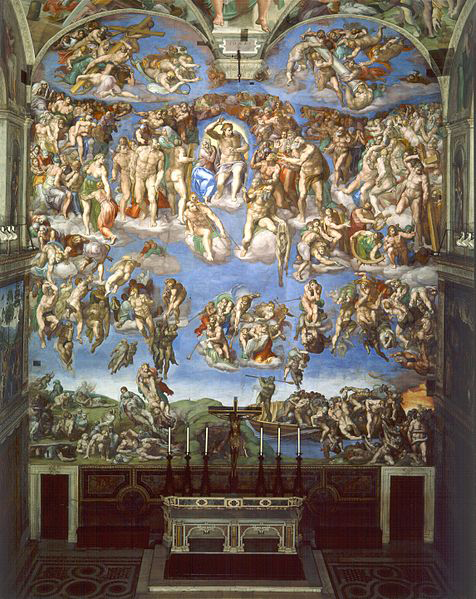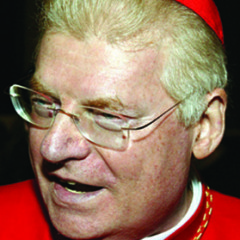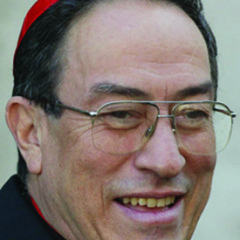(RNS) Pope Benedict XVI’s sudden announcement that he would resign by the end of the month took the church and the world by surprise, in large part because it was a move without precedent in the modern world.
But what comes next is as old and familiar as the papacy itself: Speculating about who will succeed to the Throne of St. Peter.
Indeed, within months of Benedict’s own election in 2005, church insiders and online oddsmakers were trying to figure out who might be next, given that Benedict — now 85 — was already aging, increasingly frail, and had himself declared that he did not expect his reign to be a long one.
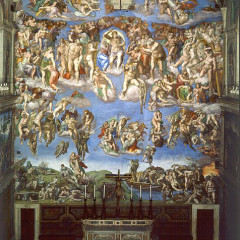
Michelangelo’s Last Judgement inside the Sistine Chapel. RNS photo courtesy Wikimedia Commons / Public Domain (http://bit.ly/156Y0IK)
So what will happen when the world’s cardinals gather before the splendor of Michelangelo’s Last Judgment fresco in the Sistine Chapel to elect a new pope? Who are the “papabile,” as the Italians say, the “pope-able” cardinals?
Will the conclave make the epochal break with the European monopoly and pick a cardinal from Latin America or Africa? The Catholic Church is booming in the Southern Hemisphere, as opposed to Europe and North America, where it is on life-support or barely treading water.
“In my eyes it would be a good thing if a candidate from Latin America or Africa were elected at the next conclave,” Cardinal Kurt Koch, a Swiss prelate who is the Vatican’s top official for dialogue with other churches, said in December.
The future of the church “does not lie in Europe,” Cardinal Gerhard Ludwig Mueller, a German who Benedict tapped last year to serve as the Vatican’s doctrinal watchdog, said in a separate interview in December. “I know a number of bishops and cardinals from Latin America who could take responsibility for the entire world Church.”
Age is also a consideration: Will the conclave look to a younger cardinal? The last decade of John Paul II’s reign was focused on his declining health, to the point that it was almost a death watch, and Benedict’s tenure has always been as much about his age as his policies.
Here is a look at some of the candidates whose names have been discussed, publicly and privately, in recent months, and their chances.
An American Pope?
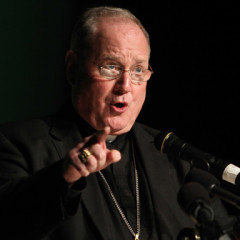
Cardinal Timothy Dolan of New York, president of the U.S. Conference of Catholic Bishops, has said talks with the White House over a proposed contraception mandate are “going nowhere.” RNS photo by Gregory A. Shemitz.
That possibility has always been dismissed out of hand, and with good reason. The United States leaves such big political, military, and cultural footprints around the globe that handing the papacy – the world’s spiritual superpower – to the Yanks would be unthinkable. But New York Cardinal Timothy Dolan, 63, has serious Roman experience – he speaks passable Italian, which is key – and connections.
Dolan’s youth and energy and media savvy would be just the kind of jolt that the church needs. Still, a Dolan papacy is a huge long shot, so if the cardinals want a North American compromise they could turn to Cardinal Marc Ouellet, a French-Canadian. Canada has a vastly different profile in the world, and Ouellet, 68, the former archbishop of Quebec, is multilingual, a disciple of Benedict’s theological views, and he served for years as a missionary in Latin America. Most important, since 2010 he’s headed the Vatican department that helps the pope select new bishops. That means he knows everyone in the hierarchy, and many owe him something.
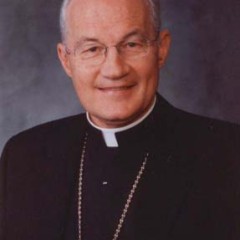
Marc Ouellet, Catholic Archbishop of Quebec and Primate of Canada, was installed as Canada’s third and highest-ranking cardinal in October. Although rumored to be papabile, the well-traveled polyglot says it’s more likely the next pope will be from Latin America. Photo courtesy Canadian Conference of Catholic Bishops.
An Obama for the papacy?
Catholicism in Africa is booming, and the idea of an African pope has long captured the imagination of many inside and outside the church. A pope from Africa would be such a visible sign of change in an institution that marks time in centuries, and yet it would also be a return to the church’s roots in the Middle East and northern Africa, where it flourished in the early centuries. It would be a clear bet on the church’s future.
If the cardinals in the conclave turn to an African, Cardinal Peter Turkson of Ghana seems most likely to get the nod. Turkson is a media-friendly, multilingual 64-year-old who has the requisite Roman experience and connections, having served as head of Benedict’s Justice and Peace Council – sort of the Vatican’s human rights commission – since 2009.
At the time of his Vatican appointment, Turkson was asked whether he thought the time was right for a black pope, given that America had its first black president in Barack Obama. “Why not?” Turkson replied. But Turkson has also made impolitic statements about Islam, which many view as the great threat facing African Christianity, and some think the time is still not ripe for a pope from the continent.
An Italian Restoration?
The Italians view the papal throne as their birthright, and having lent it to a Pole and now a German for 35 years, many say it’s time for an Italian Restoration. The favorite among the Italians would be Cardinal Angelo Scola, 71, the Archbishop of Milan. Milan has traditionally been a stepping stone for future popes, and Scola, often associated with the conservative Communion and Liberation movement, is a favorite of Benedict’s.
Scola is an intellectual, but also open to the media. Asked in October 2003 by CNN to identify the main challenge facing the church, Scola said the principal one was the “fracture” between the church and contemporary culture.
Other Italian options are Cardinal Angelo Bagnasco, 70, the strong-willed head of the Italian bishops since 2007. Bagnasco is close to Benedict and has learned to navigate the treacherous waters of both church and worldly powers. Or there is Cardinal Gianfranco Ravasi, 70, an affable scholar who peppers almost every sentence with quotations from a staggering array of classical and modern writers and philosophers. He lacks international standing, however, and has never headed a large diocese.
A papal samba? Or a tango?
Latin America is home to the greatest concentration of Catholics in the world, and Brazil has the most baptized Catholics of any country. Rio de Janeiro is hosting World Youth Day, a huge Catholic jamboree that the pope traditionally presides over, this July. It could also be a homecoming of sorts if the cardinals choose Cardinal Odilo Pedro Scherer, currently archbishop of Sao Paolo. The arguments are strong: Scherer, 63, is a German-Brazilian who has headed the largest diocese in the world’s largest Catholic country since 2007, and he studied and worked in Rome.
But Scherer could have some in-house competition from Cardinal Joao Braz de Aviz, 65, who has headed the Vatican’s congregation that oversees the world’s religious orders of priests and nuns since January 2011. He has curial credentials but also showed he wanted to change the way Rome managed its relations with religious men and women worldwide, aiming at dialogue and collaboration rather than confrontation.
Then there is Cardinal Leonardo Sandri, age 69. If the cardinals want to turn to a Latin American without leaving Rome, they could pick Sandri. He’s an Argentine, yes, but since 2000 he has been in the Roman curia, the papal bureaucracy, and is considered the ultimate Roman insider. He would be seen as a “safe pair of hands” to steer the church in difficult times and restore order to the Curia. The lack of experience at the head of a large diocese could set him back, however, and cardinals who don’t live in Rome – or love Rome, as many don’t – may not be so enamored.
The once bright star of Honduran Cardinal Oscar Andres Rodriguez Maradiaga, 70, has dimmed considerably since the media savvy prelate was the favored Latin American option at the last conclave. Still, he enjoys strong name recognition in the Catholic world.
An Asian tiger?
Asia is a small but potent source of growth and strength for the Catholic Church. Of all the bishops in this diverse continent, one stands out: Cardinal Luis Antonio Tagle, archbishop of Manila in the Philippines. At 55, he is something of a “baby bishop,” and he would be the youngest pope in centuries. But Tagle is very appealing: smiling, humble and perceptive, Tagle impressed many of his fellow bishops during the 2012 Synod on New Evangelization in Rome. He called for a more humble church that puts more effort in listening to its flock; just a few days later, Benedict made him a cardinal. Tagle – who studied at Catholic University of America in Washington – has also taken a strong approach to the sexual abuse crisis, warning his fellow bishops from Asia that they must not dismiss it as a Western phenomenon.
Still, his relative youth, and his brief experience as the head of a major diocese (he was appointed to Manila in 2011), will probably make him an outsider in this conclave.
The dark horse?
Everyone loves a long shot — the dark horse who comes out of nowhere to win by a nose. And even the cardinals do the unexpected at times. Could they go with a non-cardinal for the first time in centuries? A popular favorite would be Archbishop Diarmuid Martin of Dublin. Martin is 67, and spent nearly three decades working in the Roman curia, which gives him serious standing. But he also got the most thankless job in Christendom when John Paul sent him to Dublin a decade ago to clean up the clergy sex abuse scandal and start a reformation in the church. He has done a remarkable job, but has stepped on lots of sensitive toes in the hierarchy, even as he has won the hearts of many Irish Catholics. His outspokenness is seen by many as one reason he’s never won a cardinal’s red hat.
